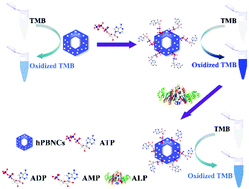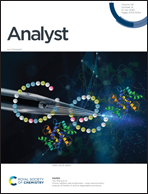ATP induced alteration in the peroxidase-like properties of hollow Prussian blue nanocubes: a platform for alkaline phosphatase detection†
Abstract
Breaking the pH limitation of the enzyme-like activity of nanomaterials is of great importance for extending their applications in environmental and biomedical fields. Herein, to mimic the role of histidine residues in horseradish peroxidase (HRP), adenosine 5′-triphosphate (ATP) is reported to improve the peroxidase-like activity of hollow Prussian blue nanocubes (hPBNCs). Due to the inherited porous structures, hPBNCs can expose all the binding sites as far as possible to ATP to significantly amplify their catalytic activity and broaden their applicable pH range up to pH 12. Introduction of ATP provides the possibility of realizing efficient catalytic reactions under alkaline conditions. Upon binding with hPBNCs, ATP can enhance the stability of hPBNCs, increase the affinities of the catalysts towards substrates and improve the conductivity of hPBNCs as well as change the decomposed product from H2O2. Moreover, on the basis of the different catalytic activities of hPBNCs towards ATP, adenosine 5′-diphosphate and adenosine 5′-monophosphate, hPBNCs–ATP is utilized to construct a novel colorimetric sensor for the detection of alkaline phosphatase (ALP) activity in biological fluids, which is significantly important for the clinical diagnosis of ALP-related diseases.



 Please wait while we load your content...
Please wait while we load your content...